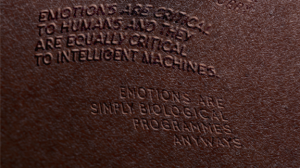Why do we trust ELIZA or PIP with our deepest secrets? Why would we invent a paranoid schizophrenic chatbot and make it talk to ELIZA? I speak to dogs, whether they understand or not, and apparently my grandma sometimes even talks to her Roomba vacuum cleaner! Anthropomorphism is something that we cannot seem to escape. What does it all say about us, and what relevance does this have? In this episode, I will express my own speculative vision, from a philosophical and psychological perspective.
Mirroring Ourselves
Our ‘hardware’ hasn’t evolved that much in the past few thousand years. We are ‘programmed’ to attribute agency, mental states and intentionality to anything that seems like it could have some. By doing this we create a model of reality in which we can predict behavior of others, which has proven to be extremely useful for our survival. With it, we cannot only predict the next move of a predator, but also the behavior of other people.
By interpreting a variety of physical properties and movements such as gestures and speech, we decode another human’s message and actually recognize him or her as a fellow human, and as trustworthy, to some extent. (Un)conscious mirroring, physically or verbally, is an important part of human communication code. Being hypersocial animals, the tiniest cues can trigger deep social responses. Now we are creating ‘virtual humans’, which also ‘know’ which parts of our social codes they need to use to get us to trust them. A simple example is ELIZA (see episode II) which mirrored keywords to ask questions, and it made her seem like she understood what you said, which likely comforted people into communicating openly. But, our social programming is not only a strength, but also a weakness: we might be easily deceived by agents that know our codes, and get us to trust them. In the next episode, I will further explore this thought.
In the century-long quest for self-knowledge, (consciously or unconsciously) attempting to replicate (parts of) ourselves has become an effective way of exploring what it means to be human. Instead of solely using introspection, we let the external mirror us and thus connect with ourselves from a different perspective.
Merging with the Machines
The Extended Mind theory, although criticized, does seem like an effective ‘thinking tool’ that we could use to further understand ourselves and the phenomenon of chatbots and virtual assistants. Instead of just mirroring ourselves, we perhaps also want to improve our functions and transcend our biological constraints. An appropriate way to do so is to ‘extend our brains’ with tools such as physical and virtual databases, calculators and other technologies that drastically improve our cognitive capacity. This wish might have shown itself long before in other kinds of technologies: religion, deities and gods which are all-knowing, could empower us and answer our questions… Now, our social urges might want to give today’s ‘technoreligion’ a face as well: instead of simply accessing our tools, we want to personify them and let them talk to us. To establish this connection, we need to find or create similarities, humanize the external.
An example of this personification: when Siri doesn’t understand what you are trying to say, instead of telling you “Error, cannot compute” it says something like “I’m not sure I understand, can you repeat that please?” It shows human manners, mirrors our communication code, and thus improves its functionality because we connect with it more easily.

Excerpt of a PIP conversation, visual by Autobahn
Our wish to grow and to improve, as well as our infinite curiosity, have made us who we are today: cultural tool-using animals full of ideas, which strive to evolve. If evolving means further merging with our technologies, it appears we’d gladly do it. We have lived in symbiosis with our technology for a significant amount of time, and it has shaped us, as we have shaped it. It offers us things like health, knowledge, transport and social opportunities. I cannot help but wonder to what extent an even more intimate connection is possible. I foresee that the future will satisfy those in need of this, a further development of intelligent personal assistants, virtual friends and perhaps lovers, which will thrive by our side.
Further Reading:
- The mind behind anthropomorphic thinking: attribution of mental states to other species
- Artificial Intelligence, artificial trust
- To make robots more human-like, we need to teach them how to be mind readers
- The Extended Mind theory by Clark and Chalmers
- Rise of the compliant machines: Sociable humanoids could help advance human-robot interaction
Episodes:
